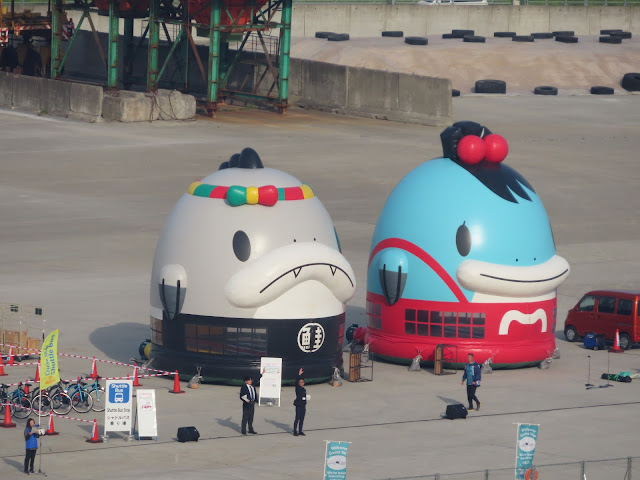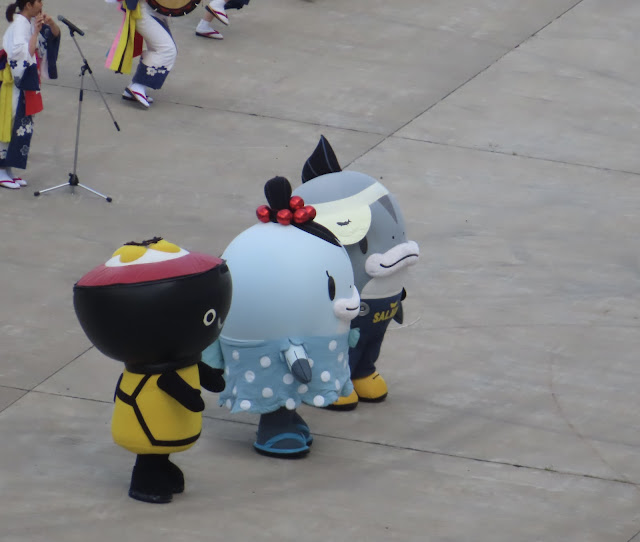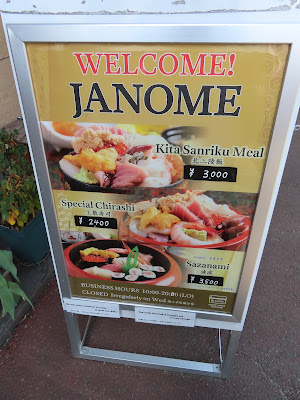Tuesday, April 30, 2024
Aomori, population 265,000, is the capital of the northernmost prefecture on Honshu, and it is a Winter City. Spring hasn’t really arrived here yet, though the snow is gone. The architecture says “winter”: the A-frame buildings, the roofs with snow-guards, the drabness, the buildings huddled together and low to the ground. I could feel it, even if I couldn’t put my finger on how I knew there were serious winters here.
We arrived on a chilly, rainy day. A pre-school class came to look at our ship and welcome us. I don’t think Aomori gets a lot of cruise ships, either.
The Wa-Rasse is housed in a striking building, where the visitor can see several of the enormous floats that have been made during the year for the Nebuta Festival Parades. During the Festival (August 2-7 every year), over 2 million people visit Aomori and participate in the boisterous dancing. (Where do they stay?)
 |
| Nebuta Museum Wa-Rasse |
The floats are very large and heavy. They have two wheels and are pushed by teams of volunteers. They are made of paper, bamboo or wood, and wire, but the wooden undercarriages that support the floats make them extremely heavy. At one time candles were used to light the floats, but now small electrical lights are placed inside the floats. Grids of India ink are painted on the paper after it has been glued on. Finally, melted paraffin and colors are applied.
 |
| Rows and rows of people get underneath the float and push it while they march along |
 |
| These are not floats, but charming little lanterns about 18 inches tall, lighting up a dark corner of the necessarily dark museum |
Shōwa Daibutsu
Seiryu-Ji Temple is a bit out of town, but that’s why it’s so nice. We went there to see the Shōwa Daibutsu (Shōwa Giant Buddha), and we got a Buddha plus an amazing garden amid wonderful scenery. The temple is not very old - it was founded in 1982. The Daibutsu was built in 1984. It is the tallest seated Buddha in Japan, at 21 meters (nearly 69 feet). It is possible to go inside the statue and see how it is constructed, but we did not do so.
The temple and buddha are located in a forested tract on the side of a mountain. It is very peaceful and beautiful. The people there seemed very welcoming and kind. We especially appreciated their assistance in calling a cab for us when we were ready to leave.
Enjoy these photos from our visit.
The first two photos show the Japanese garden. The pamphlet we received explains that stones, moss, and sand are used to represent the sea and life in harmony with nature. Isolated from noise, it is possible to immerse one’s self in an atmosphere conducive to peace and healing.
 |
| These pinwheels are for unborn children to console their souls |
 |
| Our first view of the Daibutsu emerges from the misty forest |
 |
| Visitors have placed coins around the neck of this statue as an offering |
It was a worthwhile visit. It was much less crowded than other temples we have visited, but beautiful and calming. No, I am not thinking of becoming a Buddhist.
“Rhythmic Reverberations” was performed onboard our ship by a local group called The Sansa Spectacular. It was exciting to see the dancers, drummers, and flute players from Aomori in their brilliant costumes. Most of them seemed to be high-school students.
Today’s fabric is this cheerful dobby cloth seen at ASPAM.




















































